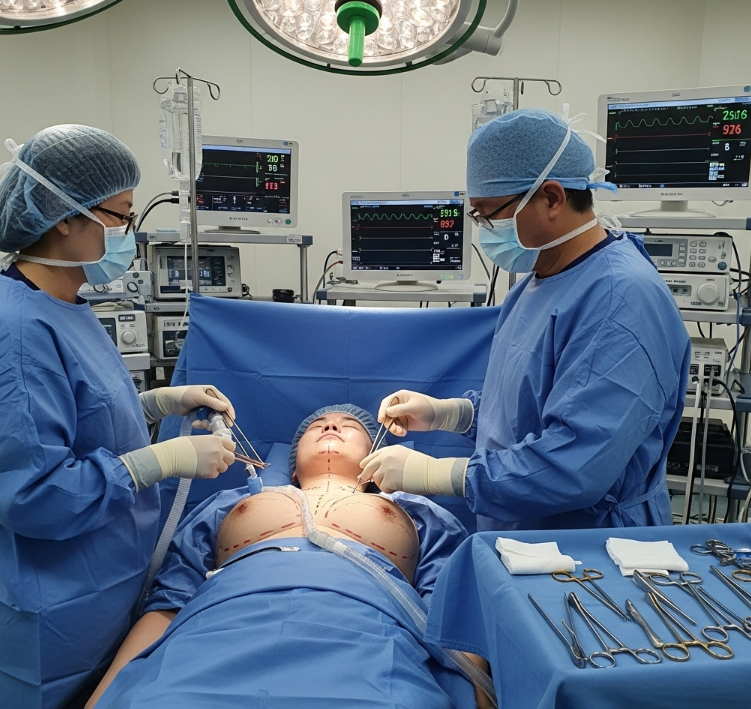Treatment Overview
Breast Augmentation, also known as augmentation mammoplasty, is one of the most popular cosmetic breast surgeries in Korea. It involves enhancing breast size and shape using implants or fat transfer techniques. Korean plastic surgeons are globally renowned for their advanced skills, natural-looking results, and use of cutting-edge technology. Unlike traditional approaches, Korean clinics prioritize minimal scarring, customized implant selection, and harmonious results that match the patient’s body proportions.
Purpose & Benefits
The main purpose of breast augmentation surgery is to enhance breast size, projection, and symmetry.
Key benefits include:
- Fuller, more voluminous breasts
- Improved body proportions and silhouette
- Enhanced breast symmetry and balance
- Correction of breast deflation after pregnancy or weight loss
- Boost in self-confidence and femininity
- Long-lasting, natural-looking results
Ideal Candidates
This surgery is ideal for individuals who:
- Desire larger or fuller breasts
- Have naturally small or underdeveloped breasts
- Experience breast asymmetry
- Lost breast volume after pregnancy, breastfeeding, or weight changes
- Are in good overall health and have realistic expectations
Possible Risks & Complications
While Korea offers some of the safest surgical environments, breast augmentation carries potential risks, including:
- Temporary pain, swelling, or bruising
- Scarring around the incision site
- Capsular contracture (scar tissue forming around the implant)
- Implant rupture or shifting (rare with modern implants)
- Changes in nipple sensitivity (temporary or permanent)
- Infection or bleeding (rare with Korean standards of sterilization)
Surgical Techniques Used
Korean surgeons utilize advanced and personalized surgical techniques to ensure optimal outcomes:
- Implant Placement Methods:
- Submuscular (under the muscle) – natural look with reduced risk of capsular contracture.
- Subglandular (under the breast tissue) – shorter recovery, more projection.
- Dual Plane Technique – a combination method offering both natural contour and upper fullness.
- Incision Techniques:
- Inframammary (under the breast crease) – allows precise implant placement with minimal visible scar.
- Periareolar (around the nipple) – discreet scarring along the areola border.
- Transaxillary (underarm incision) – scar hidden in the armpit.
- Implant Options:
- Silicone implants (most popular in Korea for natural results)
- Saline implants
- Cohesive gel “gummy bear” implants (stable shape, soft texture)
- Fat Transfer (Autologous Fat Grafting) – liposuctioned fat is purified and injected into the breasts for a natural enlargement without implants.
Recovery & Aftercare
Recovery in Korea is structured and closely monitored for safety and optimal results.
- Most patients return to light activities within 5–7 days.
- Supportive bras are recommended for several weeks.
- Swelling and tightness gradually reduce over 2–3 weeks.
- Heavy exercise or upper body workouts should be avoided for 4–6 weeks.
- Korean clinics often provide scar laser therapy, lymphatic massages, and routine check-ups to speed recovery and minimize scarring.
Results & Longevity
Results are immediately noticeable, with final breast shape settling within 2–3 months as swelling subsides. High-quality implants used in Korea can last 10–20 years or more, depending on individual conditions. Fat transfer results may vary depending on fat retention rates but generally provide long-term natural enhancement. Patients can expect youthful, symmetrical, and proportionate breasts that enhance overall body harmony.
Treatment Process in Korea
Korea has become one of the top global destinations for breast augmentation due to its unmatched surgical expertise and patient-centered care.
- Advanced Surgical Technology: Clinics use 3D imaging simulations to preview results, endoscopic techniques for minimal scarring, and high-quality FDA-approved implants.
- Unique Korean Methods: Korean surgeons are known for creating natural, balanced outcomes that fit Asian beauty ideals while also catering to international patient preferences.
- Expertise & Precision: Many surgeons in Korea are internationally trained and board-certified, performing thousands of breast surgeries annually.
- Comprehensive Medical Tourism Services: Clinics provide English-speaking coordinators, personalized consultation programs, luxury recovery facilities, and aftercare designed for international patients.
- High Safety Standards: Korea’s strict medical regulations, advanced sterilization practices, and specialized anesthesia teams ensure safe procedures with low complication rates.
Cost Range
Breast augmentation in Korea is competitively priced compared to Western countries while offering premium quality.
- Average Price Range: ₩6,000,000 – ₩12,000,000 KRW
(Approx. $4,500 – $9,000 USD) - Fat Transfer Breast Augmentation: ₩5,000,000 – ₩9,000,000 KRW ($3,800 – $7,000 USD)
- Factors Affecting Cost:
- Implant type (silicone, cohesive gel, or saline)
- Surgical technique and incision type
- Surgeon’s expertise and reputation
- Clinic’s location (Gangnam clinics typically charge more)
- Whether additional treatments (fat grafting, scar care) are included
- Extra Fees: Pre-operative tests, post-surgery medications, compression bras, and aftercare services may add ₩500,000 – ₩1,000,000 KRW ($380 – $760 USD).
Popular Clinics
Some of Korea’s leading breast augmentation clinics include:
- Banobagi Plastic Surgery Clinic – globally recognized for breast implant surgery
- JK Plastic Surgery Center – specializes in international medical tourism with VIP recovery care
- View Plastic Surgery Hospital – advanced implant technology and 3D imaging systems
- ID Hospital Seoul – one of Asia’s largest cosmetic surgery hospitals
- Regen Plastic Surgery – highly experienced in breast and body contouring surgeries




